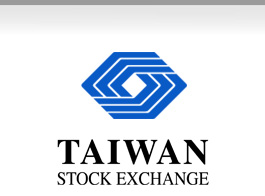Taiwan Stock Exchange
-

Taiwan Stock Exchange Invests US$90mln In State-of-Art Earthquake Proof Data Center
Lee Sush-Der, Chairman Taiwan Stock Exchange -The Taiwan Stock Exchange >>
Taiwan Stock Exchange
-

TWSE Welcomed The First Leveraged ETF And Inverse ETF In Greater China
Lee Sush-Der, Chairman Taiwan Stock Exchange - The Taiwan Stock Exchange >>
Taiwan Stock Exchange
-

TWSE Renews MOU With Warsaw Stock Exchange
Lee Sush-Der, Chairman Taiwan Stock Exchange -The Taiwan Stock Exchange (TWSE) >>
Taiwan Stock Exchange
 |
Website: TWSE Home Page Contact: Contact TWSE Map: TWSE Map |
Taiwan Stock Exchange Trading Mechanism
The trading system of the Exchange operates in a consolidated limit order book environment where only limit orders are accepted. During the regular trading session from 9:00 a.m. to 1:30 p.m., buy and sell orders can interact to determine the executed price subject to applicable automatching rules. Orders can be entered half an hour before the trading session starts at 9:00 a.m. Orders are in standard unit or multiples of standard units. One trading unit is 1,000 shares as a uniform par value of NT$10 per share is applicable to all listed stocks. Orders below 1,000 shares are considered as odd-lot orders.
In the off-hour trading session, the system accepts orders from 2:00 p.m. to 2:30 p.m. and then matches buy and sell orders at regular sessions closing prices.
In order to maintain a stable stock market, the daily price fluctuation limits of stocks, beneficiary certificates, Taiwan Depository Receipts (TDRs) and convertible bonds are set at 7% of the closing price of the preceding business day. For bonds, the limits are set at 5%. Day trade is allowed only for investors with margin accounts.
Fully Automated Securities Trading( "FAST" )
Effective May 3, 1993, all securities listed on the Exchange are traded through Fully Automated Securities Trading ( "FAST" ). Orders are executed in strict price and time priority. An order entered into the system at an earlier time must be executed in full before an order at the same price entered at a later time is executed.
Trading Mechanism under FAST System
Starting July 1st, 2002, the Exchange has adopted a series of measures for its trading system to better reflect the interaction of the supply and demand of listed securities. The ultimate goal is to enhance price integrity and market transparency. The measures include:
Eliminating the two up/down tick rule
To ensure price continuity, intra-day continuous auction was subject to the two up/down tick rule where the execution price was limited to two up/down ticks of the last executed price. To better reflect the interaction of buying and selling force, every matched price is, under the new rules, allowed to fall anywhere in the price limit of the trading day, with the intra-day volatility interruption in force (see below).
Adopting intra-day volatility interruption
With the two up/down tick rule having been eliminated, chances are that the traded prices of securities will become too volatile. To remedy this foreseeable situation, intra-day volatility interruption is applied. Whenever the trading system detects that the potential execution price of a specific stock will fall out of a specified range (+/-3.5%) of the last traded price, matching for that stock will be postponed for two to three minutes. Market participants will be informed of that situation and can modify their existing orders or enter new orders to cope with the order imbalancing of that security. However, volatility interruption is not applicable during the opening session and the last 10 minutes of regular trading hours (i.e. 1:20 p.m. to 1:30 p.m.). Those stocks whose reference price for the opening call auction is below 1 NT$ or whose matching is restricted to every 5 or 10 minutes are not subject to intra-day volatility interruption.
Adopting 5-minute closing call auction
Given that the closing price of securities is widely used by market participants as a benchmark for portfolio valuation as well as index calculation, the system accumulates orders for 5 minutes (from 1:25 p.m. to 1:30 p.m.) before the closing call auction.
| New Block Trading System Amended on April 4th , 2005 | |||||||||||||||||||||||||||||||||||||||||||||||||||||||||||||||||||||||||||||||||||||||||||||||||||||||||||||||||||||||
| Starting from April 4th 2005, Taiwan Stock Exchange launches a new block trading system to replace the obsolete system under which the execution price of block trades is restricted to the closing price of regular trading session, and the broker who participates in block trades is required to deliver funds or securities in person to the exchange before placing the order, and all the block trade orders are matched for only once for any given trading day. The aim of the new system is to increase price flexibility and to streamline operating procedure, so that the potential large position traders can fulfill their orders at lowest possible cost.
The following table demonstrates the basic characteristics of the new system: |
|||||||||||||||||||||||||||||||||||||||||||||||||||||||||||||||||||||||||||||||||||||||||||||||||||||||||||||||||||||||
|
|||||||||||||||||||||||||||||||||||||||||||||||||||||||||||||||||||||||||||||||||||||||||||||||||||||||||||||||||||||||
| The related rules for block trading are as follows: | |||||||||||||||||||||||||||||||||||||||||||||||||||||||||||||||||||||||||||||||||||||||||||||||||||||||||||||||||||||||
| Order effectiveness and cancellation | |||||||||||||||||||||||||||||||||||||||||||||||||||||||||||||||||||||||||||||||||||||||||||||||||||||||||||||||||||||||
| The block trade order remains effective only for the time span of trading session in which that order is placed. The orders can be cancelled before execution. The request to change order volume will not be accepted. | |||||||||||||||||||||||||||||||||||||||||||||||||||||||||||||||||||||||||||||||||||||||||||||||||||||||||||||||||||||||
| Pre-deposit of funds and securities | |||||||||||||||||||||||||||||||||||||||||||||||||||||||||||||||||||||||||||||||||||||||||||||||||||||||||||||||||||||||
| The securities broker entering block buying orders are required to receive funds from buying customer, while the securities broker entering block selling orders are required to notify Securities Central Deposit Company through the exchanges system to block selling customers securities holdings. | |||||||||||||||||||||||||||||||||||||||||||||||||||||||||||||||||||||||||||||||||||||||||||||||||||||||||||||||||||||||
| Usage of block trade volume and price | |||||||||||||||||||||||||||||||||||||||||||||||||||||||||||||||||||||||||||||||||||||||||||||||||||||||||||||||||||||||
| The executed volume of block trades is included in the calculation of daily calculation of trading volume. On the other hand, the executed prices of block trades are not included in index calculation or used as reference prices for opening. It is not taken into consideration when the exchange discloses the opening price, closing price, and daily highest and lowest price of individual securities. | |||||||||||||||||||||||||||||||||||||||||||||||||||||||||||||||||||||||||||||||||||||||||||||||||||||||||||||||||||||||
| Information disclosure | |||||||||||||||||||||||||||||||||||||||||||||||||||||||||||||||||||||||||||||||||||||||||||||||||||||||||||||||||||||||
| The whole order book of block trades and its trading result are disclosed in TSEC¡¦s Market Information System at http://mis.tse.com.tw/ . The information of executed block trades are broadcast to the market via information vendors. | |||||||||||||||||||||||||||||||||||||||||||||||||||||||||||||||||||||||||||||||||||||||||||||||||||||||||||||||||||||||
| Clearing and settlement | |||||||||||||||||||||||||||||||||||||||||||||||||||||||||||||||||||||||||||||||||||||||||||||||||||||||||||||||||||||||
| The block trades are to be settled before 2:30 p.m. of the trading day. | |||||||||||||||||||||||||||||||||||||||||||||||||||||||||||||||||||||||||||||||||||||||||||||||||||||||||||||||||||||||
| Adjustment for Minimum Tick Size Amended on March 1st, 2005 | |||||||||||||||||||||||||||||||||||||||||||||||||||||||||||||||||||||||||||||||||||||||||||||||||||||||||||||||||||||||
| Recognizing that the spread between best bid and ask prices constitutes a major part of investors¡¦ trading cost, the Exchange has determined to adjust the minimum tick size of certain traded products. Table 1 shows the existing tick size for various traded products of TSEC. The adjustment will take effect from March 1st, 2005. This new measure is applicable to TSEC’s stock warrants and equity products, which include stocks, certificate of entitlement to new shares, beneficiary certificate, depository receipt, foreign stocks, certificate of payment or document of title to new shares, and special shares with call warrants. The minimum tick size of other products remains unchanged.
Table 1: Minimum Tick Size for TSECs Traded Products (Before March 1st, 2005)
To allow market participants appreciate the degree the minimum tick size will be reduced, Table 2 and Table 3 demonstrate the tick size before and after March 1st, 2005 for equity products and stock warrants respectively. Table 2: Minimum tick size for Equity Products*
*:Including stocks, certificate of entitlement to new shares, beneficiary certificate, depository receipt, foreign stocks, certificate of payment or document of title to new shares, and special shares with call warrants. The impact on TSEC¡¦s equity products is: 1. The minimum tick size for price range from NT$ 5 to NT$ 10 reduced from NT$0.05 to NT$0.01; 3. The minimum tick size for price range from NT$ 50 to NT$ 100 reduced from NT$0.50 to NT$0.10; and Table 3: Minimum tick size for Stock Warrants
The impact on stock warrants is: 1. The minimum tick size for price range up to NT$ 5 reduced from NT$0.05 to NT$0.01; |
|||||||||||||||||||||||||||||||||||||||||||||||||||||||||||||||||||||||||||||||||||||||||||||||||||||||||||||||||||||||
The Electronic Information Exchange Platform(the “Platform”) developed by the TSEC provides economical and convenient services such as network management, information transfer, information safekeeping, communication transmittal agreement and communication transmittal agreement conversion (see figure 1). These services are suitable for securities firms and financial institutions to conduct businesses and help to computerize the operations of these organizations.
Figure 1 -The Platform provides network, route management and format transformation functions to users.
The major function of the Platform is to assist firms move towards electronic operations of their businesses. Since the design of the Platform was not guided by any specific profession, it will not interfere with the rights to conduct business by other business units. All firms that operate according to rules and regulations are welcome to adopt the Platform as the communication tool with other units.
The Platform solves the operation compatibility problems between securities firms and banks by electronically performing functions like settlement transfers and settlement billing. Details of the solution proposal are as follow:
1. Securities Firm and Settlement Bank Client Settlement Amount Transfer and Delivery:
1. To solve the problem of a uniform format:
(1) Coordinate the suitable uniform information transmittal format between securities firms and settlement banks.
(2) Assist settlement banks to overcome difficulties encountered when adopting a uniform information transmittal format.
2. To provide a secure, economical and convenient network environment to increase the willingness of all parties involved to connect to a central network.
3. Please refer to Figure 2 for the relationship between securities firms and settlement banks.
4. To assist and encourage securities firms and banks to enroll.
Figure 2 - Provide securities firms and settlement banks settlement information transmittal for their clients
2. Transaction Trust Information Transmittal Between Local and Foreign Institutional Investors and Securities Firms:
1. To provide convenient communication network to securities firms, institutional investors, custodian banks and the depository companies.
2. To provide uniform information transmittal format between securities firms and institutional investors for the ease of online transactions with multiple securities firms.
3. To provide communication transmittal agreement and acceptable data format to securities firms and depository companies for the ease of online transactions with multiple depositories.
Figure 3 - Provide Local and Foreign Institutional Investors and Securities Firms Trust Information Transmittal
3. Electronic Settlement Billing and Delivery Between Securities Firms and Custodian Banks:
1. To solve the inability of some custodian banks to adopt a uniform data format.
2. To assist in solving the inconvenience of certain custodian banks requiring securities firms to submit settlement inventory and signatures in person.
3. To assist and encourage securities firms and banks to enrol.
4. Please refer to Figure 4 for the relationship between securities firms, institutional investors and custodian banks.
Figure 4 - Provides Securities Firms, Local and Foreign Institutional Investors, Custodian Banks Closing, Clearance and Billing Confirmation Information Transmittal
4. Provide Required Information to Custodian and Settlement Banks to Increase Willingness of Networking with Securities Firms:
1. To assist banks to collect information through the Platform:
Information Type Source of Information and Receiving Unit Current Operation
Shareholders’ Meeting, Resignation, and Dividends Declaration ProMoney Custodian Bank
Taipei Times Custodian Bank Purchase information from ProMoney or Taipei Times, or conduct online or newspaper search then manually maintain database
Securities Closing Prices ProMoney Custodian Bank
Taipei Times Custodian Bank
Securities Dealer Custodian Bank Purchase from ProMoney or Taipei Times, or provided by securities dealers then convert data or conduct online search and manually maintain information
Securities Information (Trading Symbol, Chinese & English Name, Outstanding Shares, Types…) Nil Manual maintenance or inquire at depository server
Securities Firms Information Nil Manual maintenance
Foreign Investment Inventory Monthly Report Custodian Bank Stock Exchange Media disk provided by DIMERCO custody system and report online
2. To solve security concerns of banks connecting to external parties:
Aside from providing a secure network environment, the Platform is also able to comply with the need of banks setting up fire walls for their systems by requesting all information technology firms to provide API connection or front-office communication system such as GATEWAY or black boxes. The front-office application will be connected to the Platform; and the bank’s system server will be connected to the front-office application through a fire-walled intranet. This arrangement enables the bank to electronically operate without connecting its central systems to an external party. It also provides a solution to some of the foreign banks that do not have their system servers located in Taiwan.
1. Hardware and Software Costs for the Securities Firms:
1. Hardware: firms can maintain their current mainframe, NO EXTRA COST .
2. Connection: current firms connected to the Exchange, NO EXTRA COST . For additional connection, a 128K modem line in Taipei is approximately NT $9,000 (prices are subject to change by providers).
3. Software (currently only ETMP transmittal agreement):
(1) ETMP: new connection application needed; prices subject to quotation from providers, estimated to be NT $100,000 to $200,000 .
(2) FIX or XML (currently not available):
A. May be required to purchase additional PC communications server, estimated to be NT $100,000 to $240,000 ; firms equipped with server, NO EXTRA COST .
B. Firms equipped with FIX or XML, NO EXTRA COST .
C. Installation of new connection application estimated to be
NT $100,000 to $200,000 .
(3) If additional changes and upgrades required, then securities firm should negotiate with provider for exact pricing and quotation.
4. Platform user fee: NT $4,000 per month. (Free trial from July 2004 to July 2005, trial period may be extended depending on demand)
5. The Platform provides users with Information Exchange Platform Certificate and safety control software.
2. Hardware and Software Costs for Institutional Investors, Custodian Banks and Settlement Banks:
1. Hardware: May be required to purchase additional PC communications server, estimated to be NT $100,000 to $240,000 ; for parties equipped with server,
no extra cost.
2. Connection: For additional connection, a 128K modem line in Taipei is approximately
NT $9,000 (prices are subject to change by providers)
3. If chosen to adopt ETMP: required to purchase ETMP communications software and its connection applications, estimated to be NT $100,000 to $200,000 .
4. If chosen to adopt FIX or XML (currently not available):
A. Firms equipped with FIX or XML, NO EXTRA COST .
B. Installation of new connection application estimated to be
NT $100,000 to $200,000 .
5. If additional changes and upgrades required, then securities firm should negotiate with provider for exact pricing and quotation.
6. Platform user fee: NT $4,000 per month. (Free trial from July 2004 to July 2005, trial period may be extended depending on demand)
7. The Platform provides users with Information Exchange Platform Certificate and safety control software.
Through the transmission of business information, securities firms, institutional investors, custodian banks and settlement banks can benefit from the following:
1. Lower operation costs
Securities firms can eliminate the costs of maintaining multiple communication transmittal systems and the number of connections.
Securities firms and institutional investors can lower their labor costs since operations are now computerized by the mainframe computer.
2. Increased electronic business opportunities
Custodian and settlement banks can offer more electronic services to securities firms due to the connection to the Platform.
Securities firms can offer more electronic services to institutional investors due to the connection to the Platform.
3. Effective information management
Users of the Platform can better manage time sensitive information since the transfering of information is virtually instantaneous.
4. Lower settlement risks
Settlement delivery information is sent through the Platform to avoid it being falsified when manually processed.
Clearance efficiency will increase, allowing earlier processing results, thus lowering settlement risk.
5. Increased competitiveness by strengthening customer service
Users can provide efficient connections to their clients, strengthening customer service, thus increasing competitiveness.
6. Satisfy the need to shorten settlement period
Users can easily transmit settlement and clearance information, reducing manual labor, thus shortening the settlement period.
7. Enables international transactions
The Platform adopts international communication transmittal standard, enabling securities firms to transact with foreign units.
1. The early adoption of the information exchange platform will enable all business units to computerize operations and avoid the unnecessary reinvestments of resources.
(1) The network enables effective marketing of future securities and futures products and services.
(2) Simplify the implementation of operations for businesses involved in securities, futures and finance.
A. TSEC will assist users in selecting data transfer format and the implementation of programs.
B. For example, coordinating settlement procedures, transaction and clearance information transmittal and computerizing other operations.
(3) All business units can run operations on the Platform, eliminating the need to build and manage additional networks.
2. TSEC can provide a Platform that satisfies the needs of all units.
(1) TSEC possesses thirteen years of experience in network connection and management.
(2) The goal of the Platform is to provide all units an additional communication channel.
(3) TSEC is a reputable and disciplined organization. It is able to provide economical and fair connections to clients, avoiding inappropriate usage of information, giving clients confidence in adopting the Platform.
(4) Utilizes the current Exchange transmittal agreement to conveniently allow local securities firms to explore information exchange systems.
(5) The Platform was officially launched on July 26, 2004.
Used with Permission from TSEC website. Copyright 2006. All rights reserved




